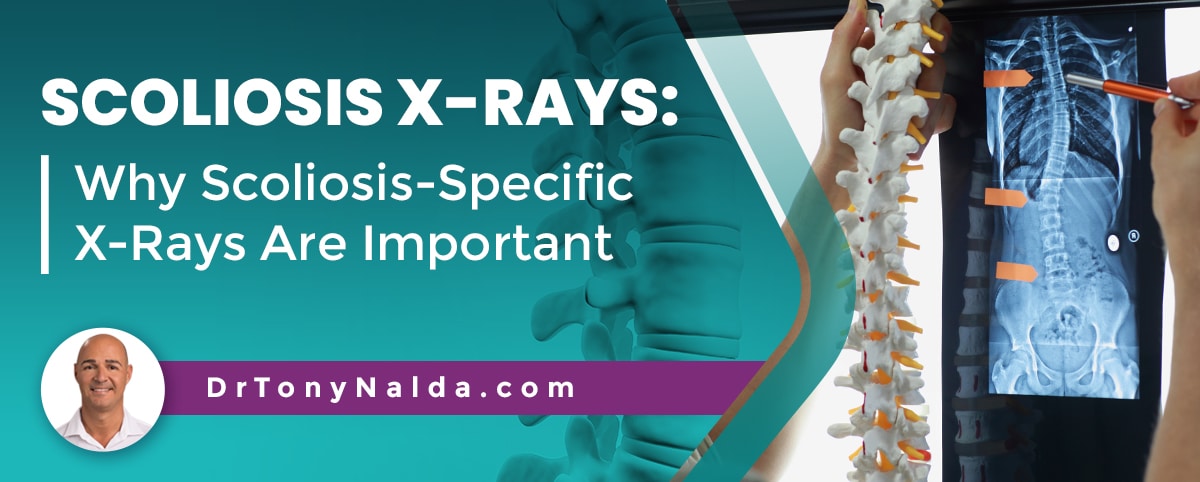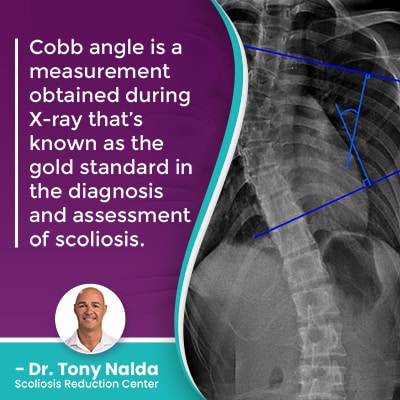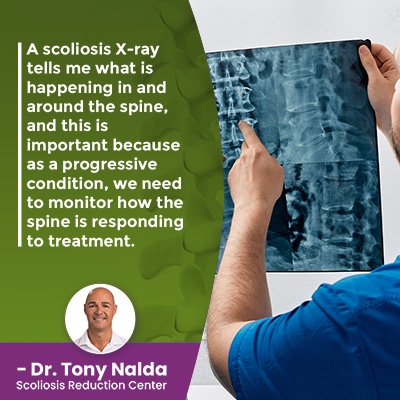Scoliosis X-Rays: Why Scoliosis-Specific X-Rays Are Important

Although scoliosis is a progressive condition, it can be highly treatable, particularly if detected early and responded to proactively. A patient’s Cobb angle measurement is known as the gold standard in the assessment of scoliosis, and this is determined via X-ray. Scoliosis-specific X-rays are helpful because they are key to reaching a diagnosis, tell me what’s happening in and around the spine, and help monitor how the spine is responding to treatment.
In order for scoliosis to be diagnosed, certain condition characteristics have to be present, one of which is determined during X-ray: a patient’s Cobb angle measurement. As such a complex condition, it’s best for patients to have their X-rays performed and interpreted by a scoliosis specialist.
Before exploring what a scoliosis X-ray can tell me about a condition, let’s start with how scoliosis is diagnosed.
Table of Contents
Diagnosing Scoliosis
In order for the spine to function optimally, it needs to have its natural curves and alignment in place; the spine’s healthy curves make it stronger, more flexible, and better able to handle mechanical stress incurred during activity.
If the spine loses one or more of its healthy curves, its biomechanics are disrupted, and this can affect the body in a number of ways.
Remember, the spine doesn’t just allow us to stand upright, practice good posture, and engage in flexible movement, the spinal cord within works in tandem with the brain to form the body’s central nervous system (CNS), which is why spinal conditions can cause such a wide range of symptoms felt throughout the body.
Scoliosis involves the development of an unnatural sideways spinal curve, with rotation, meaning the spine bends unnaturally to the side and twists from back to front, front to back.
In addition, for an unnatural spinal curve to be diagnosed as a scoliotic curve, it has to meet a size requirement: a minimum Cobb angle measurement of at least 10 degrees.
What’s a Cobb Angle?
 Cobb angle is a measurement obtained during X-ray that’s known as the gold standard in the diagnosis and assessment of scoliosis.
Cobb angle is a measurement obtained during X-ray that’s known as the gold standard in the diagnosis and assessment of scoliosis.
Scoliosis can range widely in severity from mild to moderate and severe to very severe, and severity levels are determined by a patient’s Cobb angle measurement:
- Mild scoliosis: Cobb angle measurement of between 10 and 25 degrees
- Moderate scoliosis: Cobb angle measurement of between 25 and 40 degrees
- Severe scoliosis: Cobb angle measurement of 40+ degrees
- Very-severe scoliosis: Cobb angle measurement of 80+ degrees
A patient’s Cobb angle is determined by drawing lines from the tops and bottoms of a curve’s most-tilted vertebrae, and the intersecting lines form an angle that’s expressed in degrees.
The higher a patient’s Cobb angle, the more severe the condition, and the more likely it is that its effects are going to be noticeable; in children, the main symptom of scoliosis is postural deviation, and in adults, it’s pain.
In addition, scoliosis is a progressive condition, meaning its nature is to get worse over time, and this means that where a scoliosis is at the time of diagnosis is not indicative of where it will stay, at least not without the help of a proactive treatment plan.
So a scoliosis X-ray is important for the diagnostic process, and it’s also important for monitoring how a condition is progressing and responding to treatment.
Why are Scoliosis X-Rays so Important?
 A scoliosis X-ray tells me what is happening in and around the spine, and this is important because as a progressive condition, we need to monitor how the spine is responding to treatment.
A scoliosis X-ray tells me what is happening in and around the spine, and this is important because as a progressive condition, we need to monitor how the spine is responding to treatment.
My conservative chiropractic-centered treatment approach here at the Scoliosis Reduction Center relies on scoliosis X-rays for a number of reasons.
For one, an X-ray is needed to determine a patient’s Cobb angle and reach a diagnosis, but it also tells me if progression is occurring and how the spine is responding to treatment.
I integrate multiple different types of scoliosis-specific treatment disciplines so I can fully customize treatment plans to address the specifics of a patient’s condition, and performing a scoliosis X-ray tells me what is working, what’s not, and provides me with guidance on how the different treatment disciplines can be apportioned accordingly.
If a patient is progressing, this means the size of the scoliotic curve is increasing, and a patient’s increasing Cobb angle will indicate that progression is occurring.
Scoliosis-specific X-rays should be performed by a specialist as they involve a series of images taken from different angles; I don’t just want to monitor a patient’s Cobb angle, but also the angle of trunk rotation (ATR), and other factors.
While X-rays can indicate what’s happening in and around the spine, they do have shortcomings, particularly when it comes to using 2-dimensional images to assess a complex 3-dimensional condition, but there is a right way to perform and interpret a scoliosis X-ray that minimizes those shortcomings.
Using a Scoliosis X-ray Properly
Here at the Center, I regularly use and refer to X-rays to treat my scoliosis patients effectively.
While there have been concerns about the amount of radiation X-rays expose patients to, the risk is minimal, particularly when taken with the most advanced up-to-date digital technology.
I use the most advanced digital scoliosis X-ray technology as this produces the most accurate results with minimal radiation exposure; we use small targeted X-rays that assess the stability of the spine and its biomechanical integrity for the most precise and detailed results.
The more details I know about a patient’s condition and spine, the more I can customize an effective treatment plan accordingly.
As a scoliosis chiropractor, I know scoliosis, and I know the spine, so I have the training, experience, and knowledge to interpret a scoliosis X-ray comprehensively, which is beyond the scope of a general practitioner.
I use scoliosis X-rays at various points throughout a patient’s treatment to measure progress, as a guide for where to concentrate chiropractic adjustments, helpful exercises to prescribe, and to confirm that a treatment plan is working in an efficient and effective manner.
An important factor to consider, when it comes to concerns about radiation, is to address the question of what happens if a patient’s scoliosis isn’t monitored via X-ray?
Scoliosis Progression and Treatment Efficacy
As a progressive condition, scoliosis is virtually guaranteed to get worse over time, and as scoliosis progresses, the spine gets increasingly rigid, making it less responsive to chiropractic adjustments.
In addition, increasing spinal rigidity can make it difficult for patients to perform certain therapeutic exercises that are key to treatment, and over time, the body adjusts to the unnatural spinal curve’s presence, making it more complex to treat.
Scoliosis introduces a lot of uneven forces to the body, and those uneven forces don’t just affect the spine itself, but also its surrounding muscles, and the longer scoliosis is left to progress, the more likely it is that a related muscle imbalance will develop.
The muscles on either side of the spine can become unbalanced due to the unnatural spinal curve pulling its surrounding muscles in different directions; the muscles on one side of the spine can become tight and sore from overuse, while the muscles on the other side can become weak from underuse.
While there are never treatment guarantees, scoliosis that’s detected early, and responded to with proactive treatment, is more likely to be treated successfully, and the scoliosis X-ray is a large part of achieving early detection and effective treatment.
It’s far simpler to work proactively towards preventing progression and increasing condition effects, than it is to work towards reversing those effects once they’ve developed.
Conclusion
Scoliosis is a complex structural spinal condition that involves comprehensive monitoring, assessment, and the full customization of effective treatment plans.
Not only does scoliosis range widely in severity from mild to moderate and severe to very severe, there are multiple condition types, it can affect all ages, and is progressive in nature.
The highly-variable nature of scoliosis necessitates the customization of treatment plans, which is why scoliosis is beyond the scope of general medicine, instead requiring scoliosis-specific treatment delivered by a scoliosis specialist.
Scoliosis-specific X-rays are used to diagnose a patient’s condition by confirming their Cobb angle measurement, classifying the condition based on severity, determining where along the spine the scoliosis has developed, the angle of trunk rotation, and more.
Scoliosis X-rays are also used to monitor for progression throughout treatment so I can determine how treatment is affecting the spine, and whether treatment disciplines need to be adjusted.
If scoliosis isn’t monitored consistently, progression can occur undetected, and this means the condition is becoming more complex to treat.
Here at the Center, scoliosis-specific X-rays are important because the more details I know about a patient’s condition, the more likely it is that I can treat it effectively.
Dr. Tony Nalda
DOCTOR OF CHIROPRACTIC
After receiving an undergraduate degree in psychology and his Doctorate of Chiropractic from Life University, Dr. Nalda settled in Celebration, Florida and proceeded to build one of Central Florida’s most successful chiropractic clinics.
His experience with patients suffering from scoliosis, and the confusion and frustration they faced, led him to seek a specialty in scoliosis care. In 2006 he completed his Intensive Care Certification from CLEAR Institute, a leading scoliosis educational and certification center.
About Dr. Tony Nalda
 Ready to explore scoliosis treatment? Contact Us Now
Ready to explore scoliosis treatment? Contact Us Now





